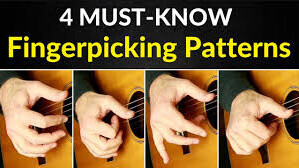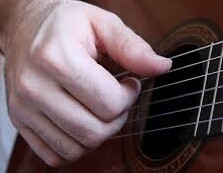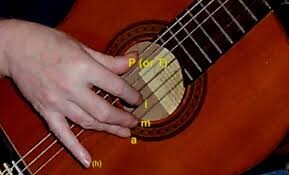
Fingerpicking might feel like learning how to drive a stick shift, but once you’ve got it down, it opens up a whole new world. It’s all about creating intimate and intricate sounds with just your fingers dancing across the strings. Let’s get cozy with the basics and see what makes this technique special.
There’s something magical about the simplicity of fingerpicking, and understanding the basic patterns is your first stop. The classic ‘p-i-m-a’ finger technique, which stands for thumb (p), index (i), middle (m), and ring (a) fingers, creates a foundation you can build on as you advance. It’s like getting the keys to a musical kingdom where practice unlocks new skills.
Before diving in, let’s make sure your instrument is ready to rock. Guitar setup matters! Adjust your guitar strings and action—a fancy word for how high the strings are off the fretboard. This ensures you get the best sound and don’t accidentally make your fingers work harder than they should, because nobody likes a hand cramp!
It’s not just about feeling the music but also hearing it. Start tuning your ear to recognize those lovely fingerpicking sounds. This means listening to seasoned fingerpickers as they glide through strings. Let those notes soak in, because appreciating sound quality is what separates a decent player from a fingerpicking maestro.
Developing Precision and Speed in Your Fingerpicking Technique
 Getting precise and quick with your fingerpicking skills isn’t just about speed. It’s about finding a perfect balance between accuracy and tempo. Efficient hand placement and finger movement are crucial. Think of your hand as an artist’s brush, ready to paint beautiful soundscapes. Positioning your thumb and fingers correctly ensures clean, clear notes without unintentional muffles.
Getting precise and quick with your fingerpicking skills isn’t just about speed. It’s about finding a perfect balance between accuracy and tempo. Efficient hand placement and finger movement are crucial. Think of your hand as an artist’s brush, ready to paint beautiful soundscapes. Positioning your thumb and fingers correctly ensures clean, clear notes without unintentional muffles.
The thumb is your bass player here; it’s got one job and that is keeping things steady. Your other fingers—thumb’s crew—handle the details, dancing over strings to create melody and harmony. Each finger has its role, playing its part in a miniature band of strings as you pick effortlessly.
Speed will come, but let’s be smart about it. Gradually ramp things up, starting slow so every note rings clear. Synchronization between your fingers and brain is key, so use a metronome to keep your timing spot on. Hearing each note shine even at a slow pace guarantees speed won’t compromise your sound.
Exercises are your secret weapon. Just like going to the gym, you’re building muscle, but for your fingers. Try exercises for finger independence, like playing scales and arpeggios or alternating simple patterns to give each finger a workout. Building strength and dexterity takes time, but with patience, you’ll see those fingers fly across the fretboard effortlessly.
Mastering Advanced Fingerpicking Styles and Patterns
 Moving into advanced territory, fingerpicking becomes even more thrilling as you weave different styles into your musical repertoire.
Moving into advanced territory, fingerpicking becomes even more thrilling as you weave different styles into your musical repertoire. - Classical fingerpicking, for example, is like mastering an intricate dance, blending precision with emotion. It demands discipline and plenty of practice, but the beautiful, flowing melodies you create are totally worth the effort.
- Ever wondered about bluegrass fingerpicking? It’s a style that feels like running through a musical marathon. Characterized by its energetic and vibrant pace, this technique involves rapid picking and hopping between strings. It might feel overwhelming at first, like trying to juggle cats, but start slow, and soon you’ll be plucking like a bluegrass pro.
- Then there’s Travis Picking—a cheeky little number popularized by Merle Travis. With a steady thumb playing bass notes and your fingers picking higher strings, this style often feels like having a friendly musical duel with yourself. Repetition helps with mastering this, as the thumb must keep a rhythm while the fingers get creative.
Integrating fingerpicking into different musical genres broadens your musical horizons. Each genre, be it folk, blues, or even rock, can absorb fingerpicking techniques differently. Exploring these diverse sounds turns you into a versatile musician capable of jumping between styles like a musical chameleon.
Overcoming Common Fingerpicking Challenges and Cultivating Creativity
 Every guitarist hits a snag or two while mastering fingerpicking, but the trick is knowing how to tackle these setbacks without throwing in the towel. Common errors, like unintended buzzing or hitting the wrong strings, often come down to finger placement or pressure. Minor adjustments in your hand positioning can make a world of difference.
Every guitarist hits a snag or two while mastering fingerpicking, but the trick is knowing how to tackle these setbacks without throwing in the towel. Common errors, like unintended buzzing or hitting the wrong strings, often come down to finger placement or pressure. Minor adjustments in your hand positioning can make a world of difference.
Finger fatigue is real, especially when you’re spending hours perfecting a piece. The key here is building endurance gradually. Don’t shy away from short break sessions. They help in keeping your fingers fresh and ready to go, so fatigue doesn’t become your worst enemy. Using a finger grip exerciser can also be a game-changer for building stamina over time.
Creating your own patterns is where fingerpicking becomes a personal expression. Experiment with different combinations and sounds. It’s like being a chef crafting a new recipe—sometimes you have to mix things up and see what works. Play around with speed, dynamics, and even syncopation to give your music a unique twist.
Technology is your friend when it comes to sharpening your skills. There’s an app for everything these days, including guitar practice. Use apps to get feedback on your technique, or simply for metronome and tuner needs. With the right tools, you can even slow down tracks to analyze them, piecing together how your favorite fingerstyle musicians perform those intricate passages.
